Use of the internet in corporate WANs is quickly growing. And for good reason.
Not only are internet services such as DIA and broadband cheaper than MPLS, many of the SaaS applications and cloud services that enterprises have adopted have been optimized to work over local internet connections rather than through central internet breakouts.
In addition, SD-WAN has emerged as a tool that allows WAN managers to incorporate these lower cost internet services into their network without sacrificing performance or security. But not every network site (or enterprise customer) is a good fit for an all internet WAN.
In our next two scenarios, we take an approach that we see many enterprises taking—designating network sites into tiers and assigning different network services to each tier. This allows companies to add in local internet breakouts at most offices, but keep some MPLS at higher priority sites that need service level assurances.
Before we dive in, if you didn’t read our original post that outlines our baseline network, make sure you go back and take a look. The following analysis will make a lot more sense if you do.
An Increasingly Hybrid Network
One of the biggest takeaways from our recent WAN Manager Survey update—in which we partnered with SG Analytics to survey an even larger pool of IT infrastructure professionals around the world? A large majority of WAN managers have or are in the process of moving to a hybrid network approach.
A large majority of WAN managers have or are in the process of moving to a hybrid network approach.
A few of our other key findings:
- Business Broadband made up the majority of WAN sites at 46%.
This contrasts with our TG panel WMS editions, where MPLS was still the most prominent product. Due to the SGA panel survey's wider net across company-types and geographies, we feel this outcome is plausible. However, we offer caution in making too much of the difference in the key enterprise global market, as some results may stem from confusion over the difference between MPLS and VPLS. - Both MPLS and DIA are reported running at similar averages of 37% and 36%, respectively.
This follows the global trend of increasing the use of internet services within global enterprises as MPLS use continues to fall.
Underlay Product Distribution, 2022
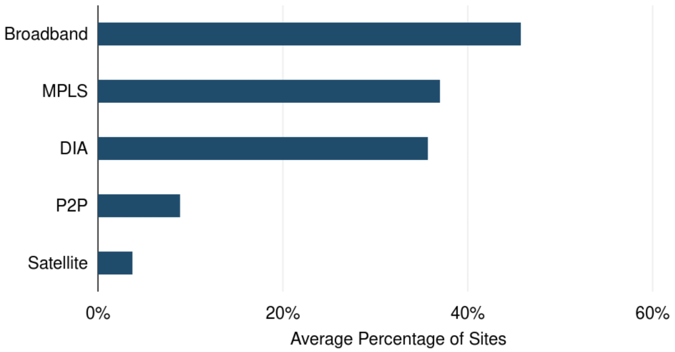
So where are each of these services being deployed across the WAN?
Respondents to this version of our survey indicated much greater parity between product bandwidth usage than in previous editions.
- Across all products, respondents indicated higher capacity utilization.
- All three products peak at the relatively high-bandwidth 101-500 Mbps range.
- At very high capacities above 1,000 Mbps, both DIA and Broadband were more prominent than MPLS, but not by a wide margin.
- MPLS was the more likely choice at the 11-50 Mbps range, which does comport with what we have seen in terms of typical MPLS port sizes elsewhere. MPLS still skews much higher capacities across the board than we have seen in other studies.
Bandwidth Distribution for Key Products, 2022
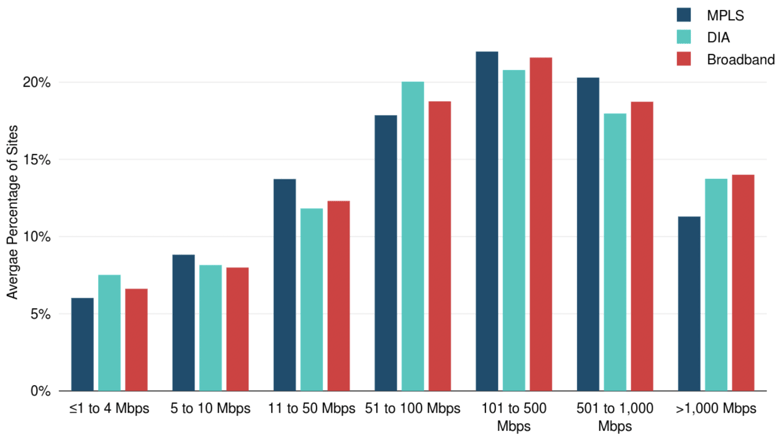 Source: TeleGeography
Source: TeleGeographyBased on all of this new intelligence, our tiered WAN scenarios model what integrating all three of these services across the WAN can do to network costs.
Let’s dive in.
Conservative Tiered WAN
Our first tiered scenario takes a conservative approach to integrating internet services and SD-WAN into the WAN. We’ve made the following changes to our original network:
- Tier 1 sites. Our Tier 1 sites are those not ready to go all-internet, perhaps similar to your headquarter sites in key metro areas. These sites still have dual MPLS at the same bandwidth, but we’ve added a tertiary DIA link of moderate size to non-data center sites.
- Tier 2 sites. Our Tier 2 sites—the biggest group—are running a single MPLS port and DIA connection to replace the lost MPLS port. The DIA ports are the same size as the original MPLS circuit that was dropped for these medium sites.
- Tier 3 sites. Our Tier 3 sites are running DIA (generally the same size as our original MPLS ports) and a broadband connection of similar or larger size for smaller sites such as those you would see in retail or expensive geographies.
- China. We have often heard from both enterprises and vendors that internet service in mainland China is extremely difficult, and many customers opt to keep MPLS in China even when moving to internet in other markets. For this reason, we keep dual MPLS for Chinese sites in all scenarios.
- SD-WAN. For all of the following scenarios, we’ll use pricing for a managed SD-WAN service as opposed to an unmanaged SD-WAN overlay sourced directly from an SD-WAN vendor.
The figure below maps out the number of sites now running each of our three services.
Conservative Tiered WAN Network Site Count by Capacity Range
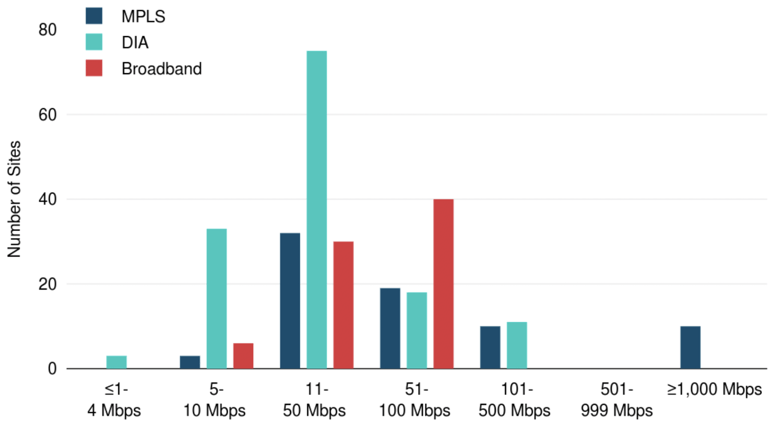
The resulting network has a global average of 403 Mbps available per site. That’s an increase of 64% over our original dual MPLS network.
Conservative Tiered WAN Average Site Capacity by Subregion
 Source: TeleGeography
Source: TeleGeography
So what does integrating internet into the WAN do to our total cost of ownership?
The figure below breaks down the original network scenario TCO (far left column) and compares it to our conservative tiered network with two SD-WAN overlay options: basic managed SD-WAN and premium managed SD-WAN, which includes some additional networking monitoring and security services.
Dual MPLS and Conservative Tiered WAN with SD-WAN Annual TCO
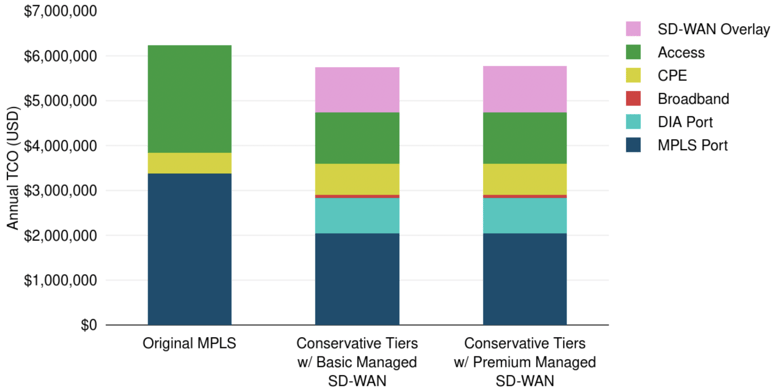 Source: TeleGeography
Source: TeleGeographyThe cost of our conservative tiered network with basic managed SD-WAN is $5,751,609. That’s 8% or $490,299 less than our original MPLS network annually.
Opting for a premium managed SD-WAN service increased the cost of the network overlay by $28,717 annually, but still resulted in a 7% savings compared to our original MPLS network.
Regular Tiered WAN
But what if, similar to our WAN Manager Survey respondents, you are ready to integrate more internet into the network?
Our next scenario takes a less conservative approach to the tiered site network model. In this scenario, we’ve made the following changes:
- Tier 1 sites. Tier 1 sites have a single MPLS port of the same size as our original network, plus a DIA port about 50% larger at large offices/HQ (not data center sites).
- Tier 2 sites. Tier 2 sites are running dual DIA ports about 50% larger than the original MPLS connections for the same markets.
- Tier 3 sites. Tier 3 sites have dual broadband connections of larger sizes than our original MPLS network.
- SD-WAN. Added managed SD-WAN to all sites.
Comparing the figure below to our conservative tiered approach, you can see the big jump in the amount of broadband connections (represented by the red columns) as well as DIA (in the turquoise columns).
Regular Tiered WAN Site Count by Capacity Range
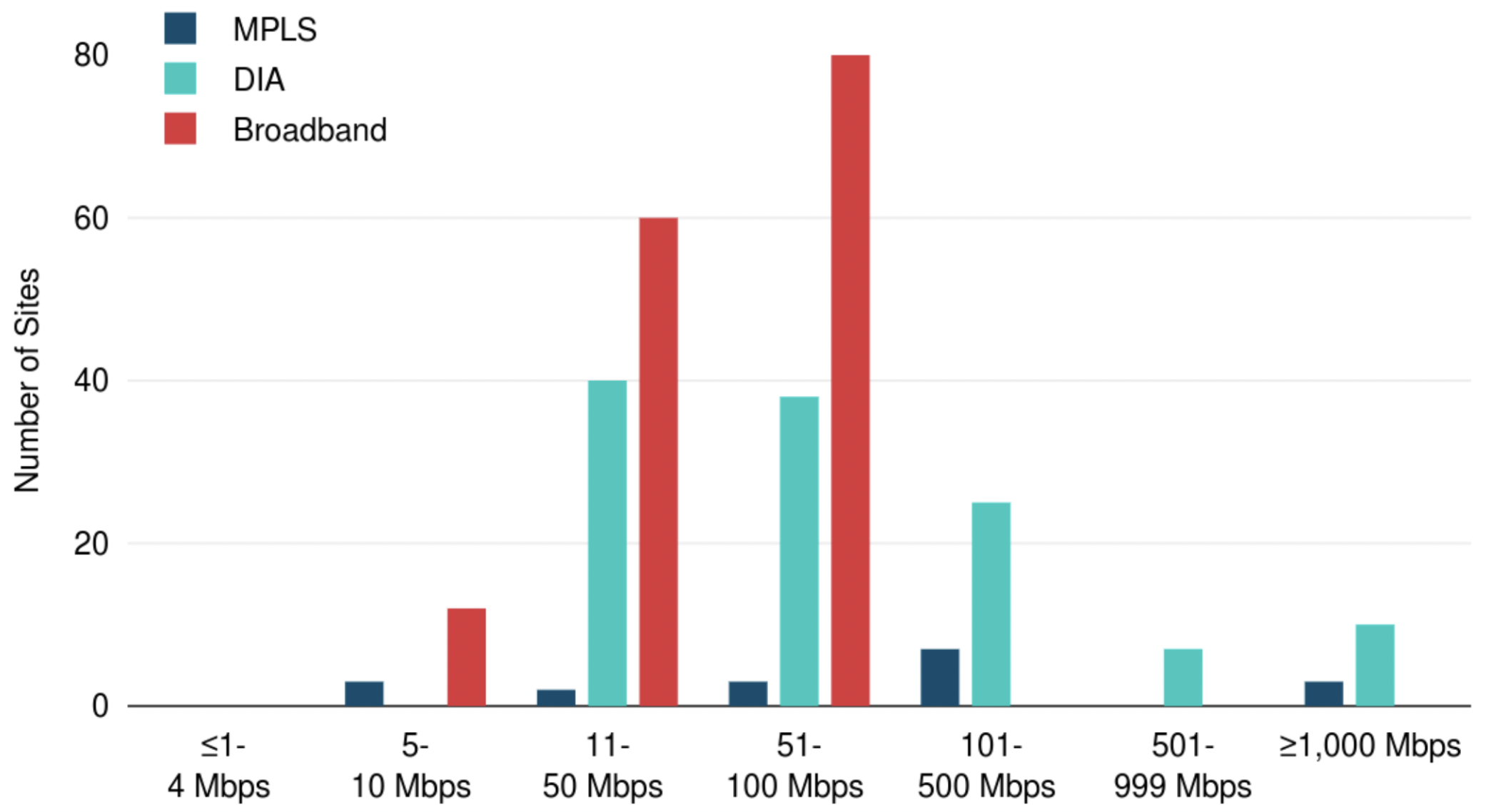
This tiered network has an average global site capacity of 435 Mbps, compared to 246 Mbps in our original dual MPLS network, or a 77% increase.
Dual MPLS and Regular Tiered WAN Average Site Capacity by Subregion
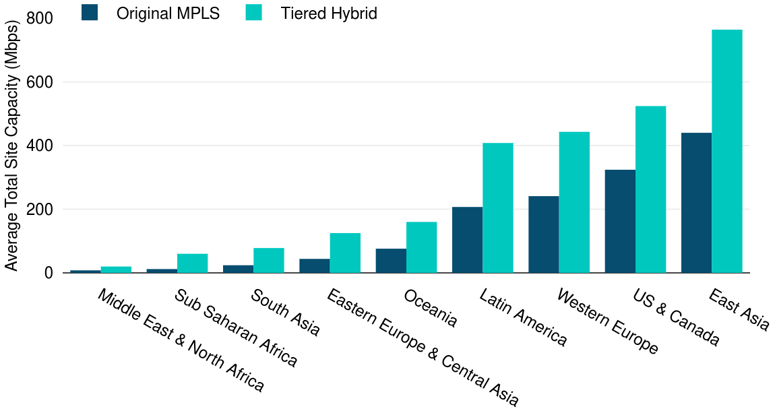 Source: TeleGeography
Source: TeleGeographyTaking a less conservative approach unsurprisingly leads to additional savings.
The TCO of our regular tiered network with basic managed and premium managed SD-WAN were 39% and 38% cheaper than the original MPLS network. The increase in the cost of our network overlay when opting for a premium managed SD-WAN service was slightly more in this scenario—a jump of $72,387 in SD-WAN costs annually.
Dual MPLS and Regular Tiered WAN with SD-WAN Annual TCO
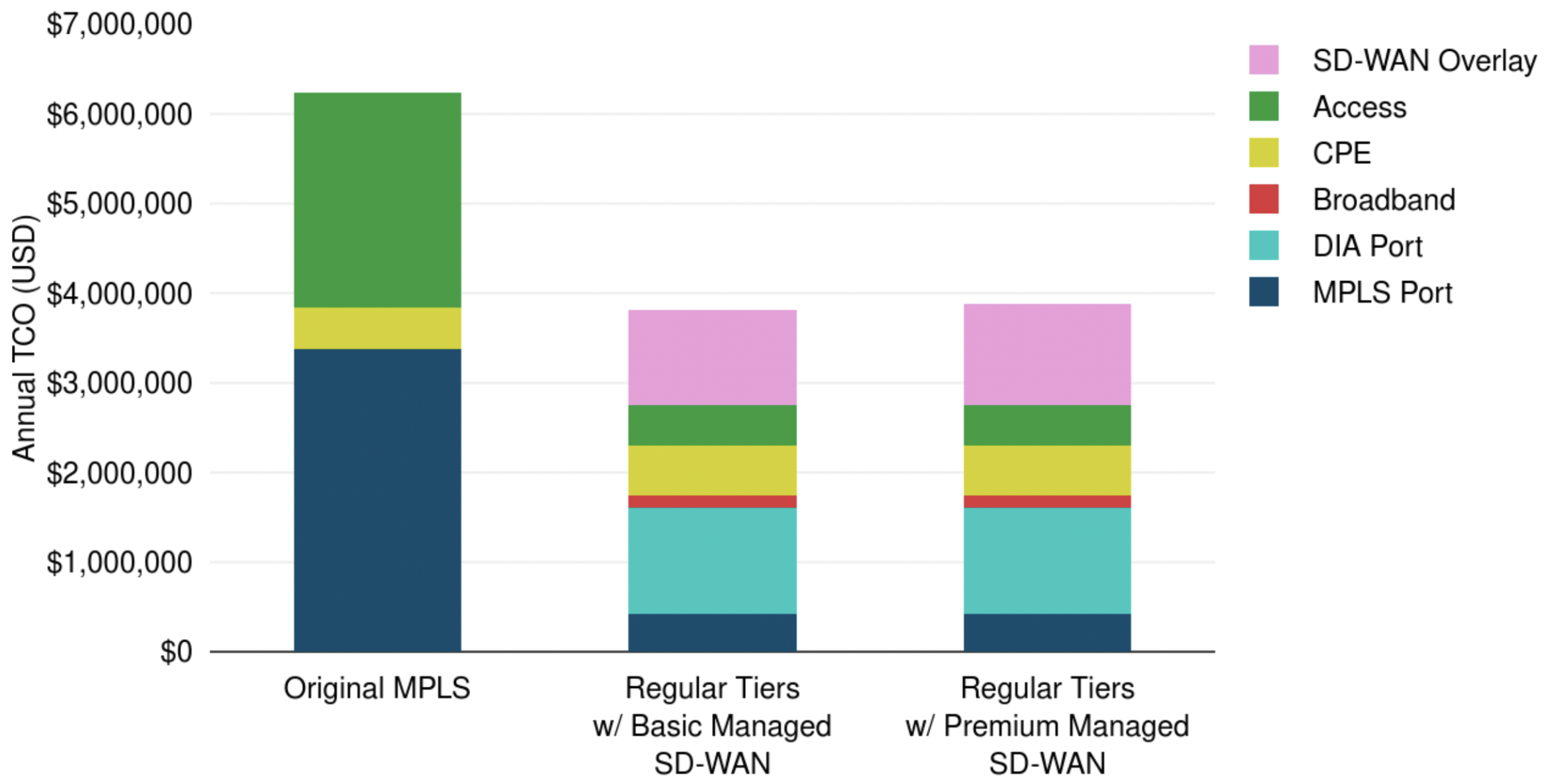 Source: TeleGeography
Source: TeleGeographyLet’s take a closer look at how the two approaches to a tiered network impact our TCO.
Using a basic managed SD-WAN service for each, you can see that while both provide network savings, opting to integrate a larger amount of broadband and DIA into the network dramatically drops the total cost of the network.
The annual TCO for our regular tiered approach was 34% less than the conservative tiered approach.
Dual MPLS and Tiered WANs with SD-WAN Annual TCO
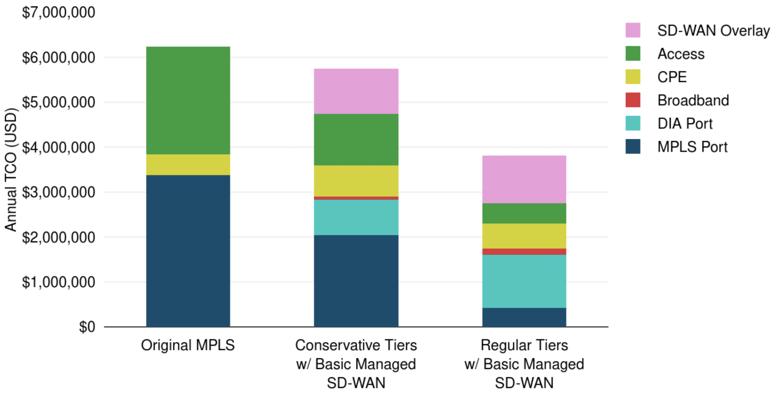 Source: TeleGeography
Source: TeleGeographyThe key takeaway from these two scenarios is that it is possible for customers to retain some MPLS in their network and still save money, particularly if they integrate it alongside more cost-effective DIA and broadband services.
It is possible for customers to retain some MPLS in their network and still save money, particularly if they integrate it alongside more cost-effective DIA and broadband services.
This provides a “best of both worlds” scenario of maintaining performance and security assurances at sites where it matters most while also utilizing more cloud application friendly, cheaper internet services.
In our next installment of this series, we’ll look at integrating private line transport into an internet first WAN to see how connecting our data center sites can impact network costs.
Up Next: BYOB (Bring Your Own Backbone) Internet WAN

Good news!
This series is now an e-book.
Download your free copy to explore all five of our hypothetical scenarios in one place.
Brianna Boudreau
Senior Research Manager Brianna Boudreau joined TeleGeography in 2008. She specializes in pricing and market analysis for wholesale and enterprise network services with a regional focus on Asia and Oceania. While at TeleGeography, Brianna has helped develop and launch several new lines of research, including our Cloud and WAN Research Service.




